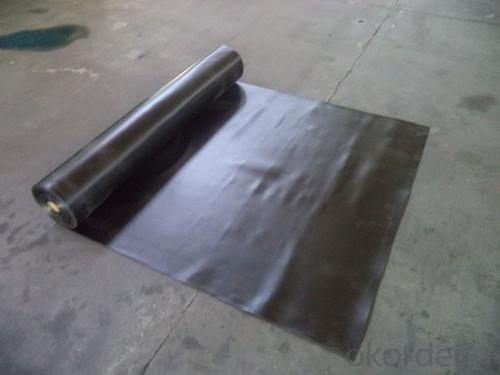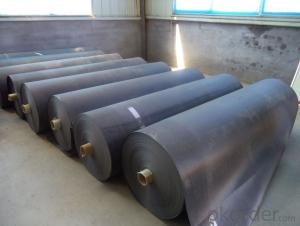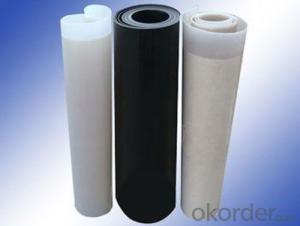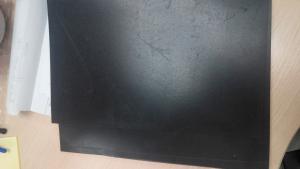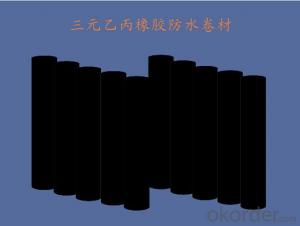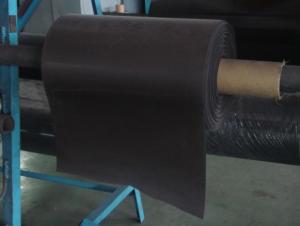EPDM roof waterproof membrane with heat resistance to 120 celsius degree
- Loading Port:
- Qingdao
- Payment Terms:
- TT OR LC
- Min Order Qty:
- 500 m²
- Supply Capability:
- 600000 m²/month
OKorder Service Pledge
OKorder Financial Service
You Might Also Like
1. Introduction
| EPDM waterproof membrane is made from ternary ethylene-propylene
rubber, which is for waterproofing of exposed and non-exposed applications.
| EPDM waterproof membrane production adopts the world-advanced equipment of
cold feeding extrusion and continuous vulcanization technology.
| EPDM waterproof membrane is of high elasticity among high polymer waterproof materials
and becomes a world-popular waterproofing material.
2. Specification
1) Material: EPDM Rubber
2) Size: 1.2m (width)*20m (length) or customized, weldable type 2.05m width
3) Thick: 1.2mm, 1.5mm, 2.0mm
4) Type: Vulcanized & Weldable
5) Pattern: Non-reinforced (homogeneous)
6) Certificate: ISO9001/14001
3. Features
| Excellent physical and mechanical performance
| High tearing resistance
| Good deformation adaptability
| High puncture resistance
| High aging resistance
| UV resistance
4. Applications
l Roofs, Basement, Toilets
l Industrial and civil building waterproofing
l Geosynthetic liner for swimming pool, channels, irrigation system
l Especially suitable for projects with high requirements in durability, anti-corrosion and
deformation.
- Q: Can waterproofing membranes be used on concrete tunnels?
- Yes, waterproofing membranes can be used on concrete tunnels. Waterproofing membranes are commonly used in construction to prevent water infiltration and protect structures, including concrete tunnels, from moisture damage. These membranes create a barrier that prevents water from seeping through the concrete and into the tunnel, ensuring its durability and longevity.
- Q: Can a waterproofing membrane be used for HVAC systems?
- No, a waterproofing membrane is not suitable for HVAC systems as it is specifically designed to prevent water penetration and does not have the necessary properties to regulate air flow or temperature control required by HVAC systems.
- Q: Can a waterproofing membrane be used for a hotel?
- Yes, a waterproofing membrane can be used for a hotel. Waterproofing membranes are commonly used in construction to protect buildings from water damage. In the case of a hotel, a waterproofing membrane can be applied to various areas such as the roof, foundation, basements, bathrooms, and balconies to prevent water leakage and moisture penetration. This is especially important in areas where water exposure is likely, such as swimming pools, spa facilities, or areas with heavy rain or high humidity. Installing a waterproofing membrane in a hotel can help maintain the structural integrity of the building, prevent mold and mildew growth, and ensure a comfortable and safe environment for guests.
- Q: Can a waterproofing membrane be installed on vertical surfaces without causing sagging or drooping?
- Yes, a waterproofing membrane can be installed on vertical surfaces without causing sagging or drooping. The key is to use a high-quality membrane that is specifically designed for vertical applications. These membranes are typically more rigid and have enhanced adhesion properties to ensure they stay in place, even on vertical surfaces. Additionally, proper installation techniques, such as correct surface preparation and ensuring good contact between the membrane and the substrate, are essential to prevent sagging or drooping.
- Q: Can a waterproofing membrane be used for elevator shafts?
- Yes, a waterproofing membrane can be used for elevator shafts. Elevator shafts can be susceptible to water infiltration, especially in locations with high water table or prone to flooding. A waterproofing membrane acts as a protective barrier against water penetration, helping to prevent damage to the elevator shaft and its components. It is an effective solution to ensure the longevity and proper functioning of elevator systems in such conditions.
- Q: Are there any specific considerations for installing a waterproofing membrane on precast concrete surfaces?
- Installing a waterproofing membrane on precast concrete surfaces requires specific considerations. Here are some important points to remember: 1. Proper Surface Preparation: Before applying the waterproofing membrane, it is crucial to prepare the precast concrete surface correctly. This involves cleaning the surface, removing loose particles, and ensuring it is dry and free from any contaminants. 2. Compatibility: It is important to select a waterproofing membrane that is suitable for precast concrete surfaces. Some membranes may not adhere well or provide effective waterproofing on this type of substrate. Therefore, it is essential to choose a membrane specifically designed for use on precast concrete. 3. Ensuring Adhesion: Properly adhering the waterproofing membrane to the precast concrete surface is vital. It is important to carefully follow the manufacturer's instructions, including any surface priming or preparation requirements for optimal adhesion. Proper adhesion will prevent water infiltration and concrete damage. 4. Joint Treatment: Precast concrete surfaces often have joints between panels or components. These joints need proper treatment to maintain the system's waterproofing integrity. This may involve using joint sealants or tapes designed specifically for waterproofing purposes. 5. Considering Durability: Consider the durability and longevity of the waterproofing membrane. Precast concrete surfaces are exposed to various weather conditions and environmental factors. Therefore, it is crucial to choose a membrane that can withstand these conditions and provide long-term protection against water penetration. 6. Quality Assurance: It is recommended to work with experienced professionals or certified installers to ensure the proper installation of the waterproofing membrane on precast concrete surfaces. This minimizes the risk of installation errors and ensures that the waterproofing system performs as intended. By considering these factors, installing a waterproofing membrane on precast concrete surfaces can effectively protect the concrete from water damage and extend its lifespan.
- Q: Can a waterproofing membrane be used for fountains or water features?
- Indeed, fountains or water features can make use of a waterproofing membrane. Such membranes find widespread use across various applications, encompassing below-grade waterproofing, roofing systems, and even ponds. Their purpose is to establish a barrier against water infiltration, thereby safeguarding the underlying structure against water-related harm. In the context of fountains or water features, a waterproofing membrane serves to avert leaks and seepage, ensuring that the water remains confined within the intended boundaries. Furthermore, these membranes typically possess flexibility and durability, rendering them well-suited for deployment in areas subject to perpetual water exposure and potential movement.
- Q: Can a waterproofing membrane be used in conjunction with energy-efficient building designs?
- Indeed, energy-efficient building designs can benefit greatly from the utilization of a waterproofing membrane. By integrating this membrane into the construction process, numerous advantages can be achieved. To begin with, the presence of a waterproofing membrane plays a vital role in shielding the building envelope from water infiltration. This aspect is crucial as it ensures the structure's integrity and longevity. By preventing water damage, the building is able to avoid costly repairs and potential energy losses caused by moisture intrusion. Moreover, a well-designed waterproofing system can contribute significantly to the energy efficiency of the building by minimizing the reliance on mechanical heating and cooling. By effectively blocking moisture from entering the building envelope, the waterproofing membrane helps to maintain a consistent indoor temperature. Consequently, this reduces the burden on HVAC systems and enhances overall energy efficiency. Furthermore, specific types of waterproofing membranes possess reflective or heat-resistant properties that can further contribute to energy savings. These membranes are capable of reflecting solar radiation, thereby diminishing the amount of heat absorbed by the building. As a result, the demand for cooling is reduced. Lastly, it is important to note that waterproofing membranes can be seamlessly integrated with other energy-efficient building components such as green roofs or rainwater harvesting systems. These additional systems not only aid in reducing energy consumption but also provide insulation, decrease stormwater runoff, and promote sustainable water management practices. Overall, the incorporation of a waterproofing membrane in energy-efficient building designs elevates both the durability and energy performance of the structure. It offers protection against water damage, lessens the load on mechanical systems, and can be harmoniously integrated with other sustainable features, thus making it a highly valuable component of energy-efficient building designs.
- Q: Can a waterproofing membrane be used for a parking garage deck?
- Indeed, a parking garage deck can benefit from the use of a waterproofing membrane. Its purpose is to safeguard the underlying structure by creating a barrier against water infiltration. Given the exposure of parking garage decks to various weather conditions and potential vehicle-related leaks, it is imperative to employ a waterproofing membrane to shield the concrete slab and prevent moisture-related problems such as cracking, corrosion, and deterioration. By implementing a waterproofing membrane on the parking garage deck, a protective layer is established, effectively blocking water from permeating the concrete. This membrane can be applied in the form of a liquid coating, sheet membrane, or a combination thereof. The selection of the appropriate membrane depends on factors including the desired level of protection, traffic load, and project-specific requirements. Moreover, a waterproofing membrane for a parking garage deck offers additional advantageous properties aside from water resistance. Some membranes are engineered to withstand chemicals and oil, which is vital considering the potential exposure to vehicles. Additionally, they provide an extra layer of defense against freeze-thaw cycles that may inflict harm upon the concrete structure. It is crucial to note that the installation of a waterproofing membrane for a parking garage deck should be carried out by experienced professionals who adhere to the manufacturer's guidelines and industry standards. Proper surface preparation, including thorough cleaning and repair of any cracks or defects, is imperative to ensure the long-term effectiveness of the membrane. In conclusion, a waterproofing membrane proves to be an effective solution for safeguarding a parking garage deck against water damage. It serves to prevent water infiltration, safeguard the concrete from deterioration, and enhance the overall durability and lifespan of the structure.
- Q: Can waterproofing membranes be used in cold climates?
- Yes, waterproofing membranes can be used in cold climates. They are designed to withstand extreme temperatures, including freezing conditions, and provide effective protection against water penetration.
Send your message to us
EPDM roof waterproof membrane with heat resistance to 120 celsius degree
- Loading Port:
- Qingdao
- Payment Terms:
- TT OR LC
- Min Order Qty:
- 500 m²
- Supply Capability:
- 600000 m²/month
OKorder Service Pledge
OKorder Financial Service
Similar products
Hot products
Hot Searches
Related keywords


